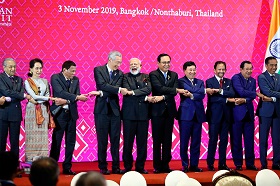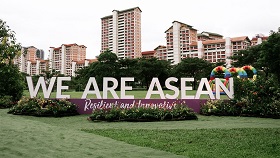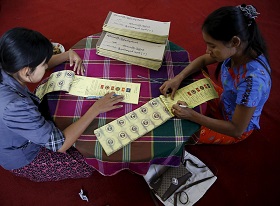On February 1, Myanmar’s population woke up in the midst of a coup. A state of emergency was declared through the military-owned Myawaddy TV. The de-facto leader Aung Saan Suu Kyi had been arrested, after having been charged for rigged elections since November.
A few hours after the coup had been launched, international media started to reveal that the armored vehicles used that morning had been made in Russia. Almost two months later, on March 27, the latest Armed Forces Day parade in Myanmar was staged in a stately way. Officials from several neighboring countries attended the event as a sign of respect. Aleksandr Fomin, Russia’s deputy Defense Minister, was spotted too.
Within the last twenty years, cooperation between Myanmar and Russia has made great strides, in the defence sector in particular. Russia, together with India and China, is among the top three arms suppliers to Myanmar. The arms market is fruitful for the Kremlin which has already gained a foothold in Southeast Asia. In 2016, the two parties signed an agreement on military cooperation, laying the legal foundations for a long-term cooperation in the military-technical sphere.
The latest events in Myanmar represent a unique opening for Russia’s global aspirations. First of all, they provide an opportunity to reassert some basic principles. Moscow has defined the February coup a “purely domestic affair of a sovereign state”. Besides, Myanmar appears to be a crucial hub connecting South Asia, Southeast Asia and East Asia. As geopolitical competition intensifies, Russia would like to have its stake in the area.
Increasing arms supplies from Russia seem indeed to be aimed at offsetting the Chinese monopoly in that specific field. Despite its deep partnership with China, Russia may try to take advantage of this situation and work as a counterbalancing factor in the country.
On February 1, Myanmar’s population woke up in the midst of a coup. A state of emergency was declared through the military-owned Myawaddy TV. The de-facto leader Aung Saan Suu Kyi had been arrested, after having been charged for rigged elections since November. Tanks were rolling in and blocking the streets of the capital Naypyidaw.
A few hours after the coup had been launched, international media started to reveal that the armored vehicles used that morning had been made in Russia. Almost two months later, on March 27, the latest Armed Forces Day parade in Myanmar was staged in a stately way. The Tatmadaw’s chief, Min Aung Hlaing, delivered a public speech. Officials from several neighboring countries attended the event as a sign of respect. Aleksandr Fomin, Russia’s deputy Defense Minister, was spotted too.
Experienced observers may have noticed that this was not the first high-level visit by Russia’s Defence Ministry. Back in 2013, Sergey Shoigu, the Russian Minister of Defence, visited Myanmar on the occasion of the 65th anniversary of diplomatic relations between the two countries [1]. Russia’s interest in the Southeast Asian country has been steadily growing since the dawn of the new millennium, and Fomin’s attendance to the army’s parade confirms it.
Old friends of convenience
Even if Russia’s interest in Myanmar may have not been that tangible before the latest events in the country, Russia and Myanmar are old friends. Back in 1948, when Myanmar gained independence, the Soviet Union was one of the first powers willing to recognize it and exchange diplomatic missions [2].
1955 marked a cornerstone in the bilateral relations. The then Secretary General Nikita Khruschev and Prime Minister Nikolay Bulganin paid a visit to Southeast Asia and stopped, in particular, in Myanmar in order to forge closer ties with the Non-Aligned Movement.
At the time, the USSR was trying to exploit the anti-British and anti-imperialistic sentiments in the country. The old slogan “you are either with us, or against us” had been put aside in order to strip any country from the Western bloc. However, following the 1962 coup, Myanmar started to turn inwards, as decades of isolationism in Myanmar’s foreign policy followed. In early 1990s, with the collapse of the Soviet Union, little changed [3].
A real breakthrough only came at the turn of the 21 st century. The two countries entered the new millennium with a Joint Declaration on the Basic Principles of Bilateral Relations. Since then, Russia has persistently supported Myanmar’s sovereignty and the principle of non-intervention in internal affairs of other states. This rhetoric declarations especially materialized in 2007 and 2017, when Moscow used its veto power within the UNSC to prevent action on alleged human rights violations in Myanmar [4].
Boosting military cooperation
Within the last twenty years, cooperation between Myanmar and Russia has made great strides, in the defence sector in particular. Before reapproaching the Southeast Asian country directly, Moscow initiated cooperation with ASEAN in 1996.
According to a 2020 survey by the Stockholm International Peace Research Institute (SIPRI), arms transfers from Moscow account for 15% of the whole arms imports in Myanmar. Russia, together with India and China, is thus among the top three arms suppliers to Myanmar. The arms market is fruitful for the Kremlin which has already gained a foothold in Southeast Asia.
At the beginning of the 21 st century, the Southeast Asian country received MiG-29 and Su-27 jet fighters from Russia for the first time. In 2009, another 400-million-euro contract was signed for acquiring Russian MiG-29 fighters [5]. In January, Moscow accepted to supply Naypyidaw with Orlan-10E surveillance drones, Pantsir S-1 surface-to-air missile systems and radar equipment [6].
In 2016, the two parties signed an agreement on military cooperation, laying the legal foundations for a long-term cooperation in the military-technical sphere. The basics of the document consist in cooperation in topography, hydrography, military education, but also in the exchange of key information on international security issues. In 2018, the cooperation went further to include counterterrorism [8]. Last year, the Myanmarese forces joined the Kavkaz-2020 military exercise launched by the Russian Federation [9].
Moreover, Russia has long tried to use its nuclear diplomacy in the Southeast Asian country. The nuclear field development immediately brought the will of acquiring nuclear weapons to the minds of some states. In order to smooth the waters, in 2015, the two parties signed a Memorandum of Understanding for Cooperation in the Peaceful Use of Nuclear Energy. Moreover, a Joint Statement on No First Placement of Weapons in Outer Space was issued in October.
A unique chance for Moscow’s plans
The latest events in Myanmar represent a unique opening for Russia’s global aspirations. First of all, they provide an opportunity to reassert some basic principles. Moscow has defined the February coup a “purely domestic affair of a sovereign state”. Alongside with China, Russia has not endorsed the latest UN Resolution concerning Myanmar. At a time when the Russian Federation is itself under attack for alleged human rights violations, the Kremlin is trying to preserve the idea of non-interference in internal affairs of other states.
Second, Myanmar is located in a geostrategic location in front of the Indian Ocean. The country appears to be a crucial hub connecting South Asia, Southeast Asia and East Asia. Different players are interested in the region, such as China, India and the United States. As geopolitical competition intensifies, Russia would like to have its stake in the area.
Myanmar, for instance, plays a starring role within the Chinese Belt and Road Initiative. However, lately, we have experienced mounting anti-Chinese sentiments in Myanmar, which materialized in the attack against some Chinese-run factories as well as in the boycott of Chinese goods, such as Huawei products [10]. Despite close ties, there is a perceived wariness of the Chinese neighbor in Naypyidaw.
Increasing arms supplies from Russia seem indeed to be aimed at offsetting the Chinese monopoly in that specific field [11]. Despite its deep partnership with China, Russia may try to take advantage of this situation and work as a counterbalancing factor in the country.
Russia’s interest in Myanmar stems not only from the will to play a geopolitical role in the region. The violent military crackdown in Myanmar has been threatening the minorities, such as the Karen, living in the country. According to some activists, the Rohingya Muslim minority has been discriminated against even more than usual in the aftermath of the coup [12].
This particular point does not have to be underestimated. In 2017, Ramzan Kadyrov led a huge demonstration in the Chechen city of Grozny in favor of the Myanmarese Muslims. The Chechen leader went as far as to declare that he was ready to go against the Russian president Putin in case Moscow decided to support the oppressing side [13]. This means that the Russian interest in Myanmar partly affects its internal stability, as the Russian popular opinion, especially in Northern Caucasus, seems to be quite sensitive about the issue.
As the military coup has been condemned throughout the world, right now Myanmar needs Russia as much as Russia needs Myanmar. The path for preserving the great power status inevitably leads to such a strategic region as Southeast Asia, with Russia not going to miss this chance.
REFERENCES
- Cranckshaw, E. (1963). The New Cold War: Moscow v. Pekin. Penguin, 1-200.
- Gjerde, K. L. (2017). Russia's turn to Asia: Myanmar seen from Moscow. Norwegian Institute for International Affairs (NUPI).
- Lutz-Auras, L. (2015). Russia and Myanmar–Friends in Need? Journal of Current Southeast Asian Affairs, 34(2), 165-198.
-
- Shendrikova, D. (2017). Why the Myanmar crisis makes Russia choose between Muslim and Buddhist minorities inside. ISPI, 1-2.
- Sumsky, V., Hong, M., & Lugg, A. (Eds.). (2012). ASEAN-Russia: foundations and future prospects. Institute of Southeast Asian Studies, 1-376.
LINKS
- Daly, J. (2020). Russia’s Kavkaz-2020: International Participation and Regional Security Implications. The Jamestown Foundation. Available at https://jamestown.org/program/russias-kavkaz-2020-international-participation-and-regional-security-implications/ (last accessed on March 26, 2021).
- Jaffrey, S. (2021). End of Myanmar’s Rocky Road to Democracy? Carnegie Endowment for International Peace. Available at https://carnegieendowment.org/2021/02/02/end-of-myanmar-s-rocky-road-to-democracy-pub-83774 (last accessed on March 24, 2021).
- Kyaw, M. Y. (2021). Why are Myanmar’s anti-coup protesters angry at China? South China Morning Post. Available at https://www.scmp.com/week-asia/politics/article/3125583/why-are-myanmars-anti-coup-protesters-angry-china (last accessed on March 29, 2021).
- Mezzera, M. (2021). The Neighbor’s Dilemma: Unpacking China-Myanmar Ambiguous Relationship. ISPI online. Available at https://www.ispionline.it/en/pubblicazione/neighbours-dilemma-unpacking-china-myanmar-ambiguous-relationship-29814 (last accessed on March 29, 2021).
- Ministry of Foreign Affairs of the Russian Federation (2018). Press release on signing the Agreement between the Government of the Russia Federation and the Government of the Republic of the Union of Myanmar on Counter-Terrorism Cooperation. Available at https://www.mid.ru/en/maps/mm/-/asset_publisher/y964jCwJXoTw/content/id/3193450 (last accessed on March 30, 2021).
- Pavlova, U. & Sauer, P. (2021). Russia to Deepen Ties With Myanmar Military Junta, Top Defense Official Says in First Visit After Coup. The Moscow Times. Available at https://www.themoscowtimes.com/2021/03/26/russia-to-deepen-ties-with-myanmar-military-junta-top-defense-official-says-in-first-visit-after-coup-a73387 (last accessed on March 26, 2021).
- TASS (2016). Russia and Myanmar sign agreement on military cooperation. TASS State Agency. Available at https://tass.com/defense/882419 (last accessed on March 28, 2021).
- United Nations Security Council (2007). Security council fails to adopt draft resolution on Myanmar, owing to negative votes by China, Russian Federation. United Nations Meetings Coverage and Press Releases. Available at https://www.un.org/press/en/2007/sc8939.doc.htm (last accessed on March 26, 2021).
- Westerman, A. (2021). What Myanmar’s Coup Means For The Rohingya. NPR. Available at https://www.npr.org/2021/02/11/966923582/what-myanmars-coup-means-for-the-rohingya (last accessed on March 26, 2021).
1. Lutz-Auras, L. (2015). Russia and Myanmar–Friends in Need? Journal of Current Southeast Asian Affairs, 34(2), p. 185.
2. Lutz-Auras, L. (2015). Russia and Myanmar–Friends in Need? Journal of Current Southeast Asian Affairs, 34(2), p. 170.
3. Cranckshaw, E. (1963). The New Cold War: Moscow v. Pekin. Penguin, p. 71.
4. United Nations Security Council (2007). Security council fails to adopt draft resolution on Myanmar, owing to negative votes by China, Russian Federation. United Nations Meetings Coverage and Press Releases. Available at https://www.un.org/press/en/2007/sc8939.doc.htm (last accessed on March 26, 2021).
5. Sumsky, V., Hong, M., & Lugg, A. (Eds.). (2012). ASEAN-Russia: foundations and future prospects. Institute of Southeast Asian Studies, p. 153.
6. Pavlova, U. & Sauer, P. (2021). Russia to Deepen Ties With Myanmar Military Junta, Top Defense Official Says in First Visit After Coup. The Moscow Times. Available at https://www.themoscowtimes.com/2021/03/26/russia-to-deepen-ties-with-myanmar-military-junta-top-defense-official-says-in-first-visit-after-coup-a73387 (last accessed on March 26, 2021).
7. TASS (2016). Russia and Myanmar sign agreement on military cooperation. TASS State Agency. Available at https://tass.com/defense/882419 (last accessed on March 28, 2021).
8. Ministry of Foreign Affairs of the Russian Federation (2018). Press release on signing the Agreement between the Government of the Russia Federation and the Government of the Republic of the Union of Myanmar on Counter-Terrorism Cooperation. Available at https://www.mid.ru/en/maps/mm/-/asset_publisher/y964jCwJXoTw/content/id/3193450 (last accessed on March 30, 2021).
9. Daly, J. (2020). Russia’s Kavkaz-2020: International Participation and Regional Security Implications. The Jamestown Foundation. Available at https://jamestown.org/program/russias-kavkaz-2020-international-participation-and-regional-security-implications/ (last accessed on March 26, 2021).
10. Kyaw, M. Y. (2021). Why are Myanmar’s anti-coup protesters angry at China? South China Morning Post. Available at https://www.scmp.com/week-asia/politics/article/3125583/why-are-myanmars-anti-coup-protesters-angry-china (last accessed on March 29, 2021).
11. Macan-Markar, M. (2021). Myanmar embraces Russian arms to offset China's influence. Nikkei Asia. Available at https://asia.nikkei.com/Spotlight/Myanmar-Coup/Myanmar-embraces-Russian-arms-to-offset-China-s-influence (last accessed on March 30, 2021).
12. Westerman, A. (2021). What Myanmar’s Coup Means For The Rohingya. NPR. Available at https://www.npr.org/2021/02/11/966923582/what-myanmars-coup-means-for-the-rohingya (last accessed on March 26, 2021).
13. Shendrikova, D. (2017). Why the Myanmar crisis makes Russia choose between Muslim and Buddhist minorities inside. ISPI, p. 2.







